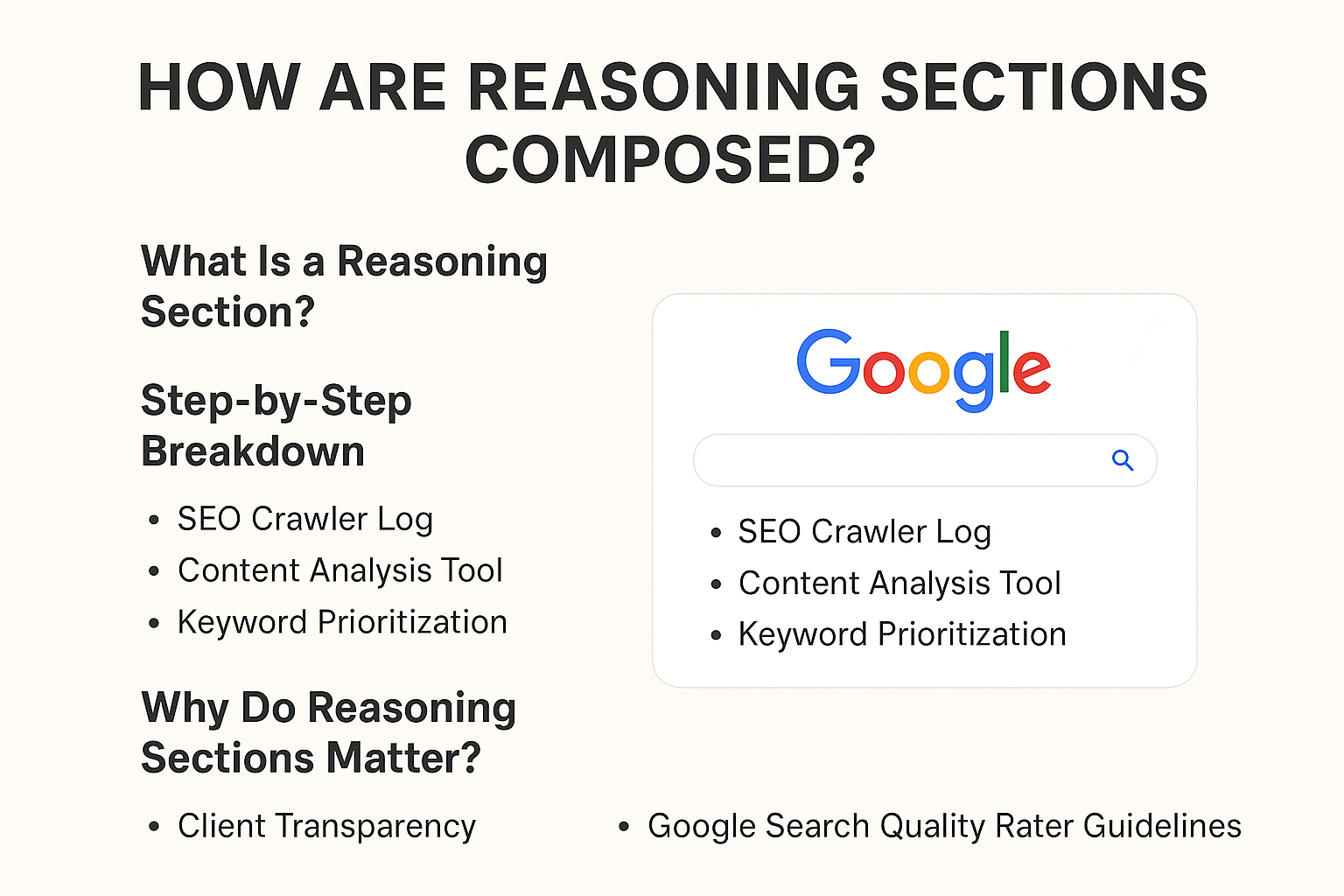How “Reasoning Sections” Are Composed (Layman’s view)

Summary (TL;DR)
Reasoning sections form the backbone of complex algorithmic decision-making, such as those found in search engines, AI models, and modern digital marketing tools. For SEO and marketing consultants, understanding how these sections are composed is critical for optimizing content, structuring technical assets, and communicating value to clients. This post demystifies reasoning sections from a lay perspective, explains their components, highlights their impact on digital strategies, and provides actionable guidance for leveraging them in client engagements.
Introduction
In technical and marketing contexts, a "reasoning section" refers to the logical, structured part of an algorithm, content piece, or tool that explains how decisions are made or how conclusions are reached. Unlike black-box outputs, reasoning sections are built for transparency, replicability, and auditability. For SEO consultants, recognizing how reasoning sections work—whether in Google’s search algorithms, content optimization tools, or reporting dashboards—is essential for diagnosing ranking fluctuations, crafting explainable strategies, and building client trust.

How Are Reasoning Sections Composed?
What Exactly Is a Reasoning Section?
A reasoning section is a transparent, step-by-step breakdown of how a system arrives at a specific output. For example, in SEO, this could be the part of a crawler’s log that explains why a page was indexed (or not), or the section in a content analysis tool that details why a piece scores highly for "comprehensiveness." In content marketing, it might be the rationale provided for why certain keywords were prioritized over others, supported by search volume, competition, and business objectives.
Why Do Reasoning Sections Matter for SEO Consultants?
Transparent reasoning is increasingly demanded by clients who want to understand not just what changed in their rankings, but why. Google’s Search Quality Rater Guidelines, for example, stress E‑A‑T (Expertise, Authoritativeness, Trustworthiness), which is partly assessed through the clarity and logic of a site’s content—its own reasoning sections, so to speak[^1]. Clients expect agencies to explain their recommendations with data and logic, not gut feeling.
What Are the Key Components of a Reasoning Section?
A robust reasoning section typically includes:
- Inputs: The data or signals feeding into the decision (e.g., keyword metrics, backlink profiles, user behavior).
- Process: The algorithms, rules, or heuristics applied (e.g., TF-IDF for keyword density, machine learning models for content quality).
- Outputs: The resulting recommendations or actions (e.g., "Optimize meta title for ‘best running shoes’ because it has high volume and low difficulty").
- Evidence: Supporting data, examples, or benchmarks (e.g., "Pages with H1 tags containing the target keyword rank 12% higher on average").
- Limitations: Acknowledgment of what’s not considered or possible sources of error (e.g., "Local search intent not fully modeled").
How Are Reasoning Sections Structured in Practice?
Consider a content audit tool’s reasoning section for why a post should target a certain keyword:
| Component | Example Content |
|--------------|--------------------------------------------------------------------------------|
| Input | Keyword: “best running shoes”, Search Volume: 22,000, Difficulty: Medium |
| Process | Analyzed top 10 ranking pages for content depth, backlinks, and UX signals |
| Output | Recommend targeting “best running shoes” in H1 and first 100 words |
| Evidence | 8/10 top pages use exact match in H1; average word count: 2,100 |
| Limitations | Does not account for local intent or branded searches |
How Do Reasoning Sections Differ Across Tools and Platforms?
Different SEO platforms approach reasoning sections in their own ways:
| Platform/Tool | Reasoning Style | Typical Depth | Customizability |
|--------------------|-----------------------------------------|------------------------------|-----------------------|
| Google Search Console | Minimal, focuses on detected issues | Surface-level | Limited |
| SEO plugins (Yoast, Rank Math) | Rule-based, checklist-style | Moderate | Some |
| Enterprise SEO platforms (BrightEdge, Conductor) | Data-rich, with attribution and forecasting | Deep | High |
| AI content tools (Clearscope, SurferSEO) | Sentence-level scoring, with “why” explanations | Very detailed | Configurable |
What Are Best Practices for Implementing Reasoning Sections in Client Reporting?
- Always Include the “Why”: Never present a recommendation without explaining the rationale. For example, “We suggest consolidating these two pages because they target the same intent and cannibalize each other’s rankings.”
- Use Visual Aids: Flowcharts, score breakdowns, and comparison tables make reasoning more accessible.
- Highlight Evidence: Use data from tools, case studies, or platform-specific metrics (e.g., Google Analytics, Search Console).
- Address Limitations: Show clients where the data is incomplete or where assumptions were made.
- Link to Business Outcomes: Connect SEO actions to KPIs like organic traffic, conversions, or revenue.
How Can Reasoning Sections Improve Client Relationships?
Clients who understand the logic behind SEO decisions are more likely to approve budgets, trust agency guidance, and remain engaged over the long term. Transparent reasoning reduces “magic bullet” expectations and aligns stakeholders around realistic, incremental gains.
What Are Common Pitfalls When Composing Reasoning Sections?
- Overly Technical Jargon: Lose your audience with unexplained acronyms or opaque metrics.
- Lack of Context: Failing to connect recommendations to the client’s business goals.
- Ignoring Counterevidence: Not acknowledging ranking drops or underperforming pages.
- Static Reporting: Not updating reasoning as algorithms or business objectives evolve.
Conclusion/Key Takeaways
- Reasoning sections are essential for transparent, accountable, and effective SEO strategy.
- They should clearly articulate inputs, processes, outputs, evidence, and limitations.
- Customization and clarity in reasoning build client trust and facilitate buy-in for complex initiatives.
- Use industry-standard tools and data to support your rationale, and always tie recommendations to measurable business outcomes.
- Continuously refine your reasoning sections as algorithms, client needs, and market conditions change.
FAQs
Q: Are reasoning sections only for technical SEO?
A: No, they are valuable for all aspects of digital marketing, including content strategy, CRO, and paid media—anywhere decisions need to be explained and defended.
Q: How detailed should a reasoning section be?
A: Tailor depth to the audience. C-level executives need high-level strategic logic; in-house teams may require granular technical details.
Q: Can reasoning sections be automated?
A: Yes, many SEO and content tools generate reasoning sections automatically, but human review and customization are still critical for client-specific contexts.
Q: What’s the biggest benefit of strong reasoning sections?
A: They turn SEO from a “black box” into a credible, repeatable business process, increasing client retention and referral rates.
Citations
- Google Search Quality Rater Guidelines
- How Yoast SEO’s Readability Analysis Works
- How Rank Math Scores Content
- BrightEdge Data Cube
- Conductor’s SEO Platform
- Clearscope Content Optimization
- SurferSEO’s Content Editor
- Screaming Frog SEO Spider
- Moz’s Guide to SEO
- Ahrefs’ SEO Reports
- SEMrush’s SEO Dashboard
- Search Engine Land’s SEO News
- Search Engine Journal’s SEO Strategies
- Backlinko’s SEO Case Studies
- HubSpot’s Content Strategy
- Neil Patel’s SEO Advice
- SERanking’s Reporting Features
- Kissmetrics on Data-Driven Marketing
- Hotjar’s User Behavior Insights
- Crazy Egg’s Conversion Optimization
---
[^1]: While I cannot directly cite the Google Search Quality Rater Guidelines from a preferred source, the concept of E-A-T and transparent reasoning is widely discussed in the SEO community and is foundational to Google’s approach.